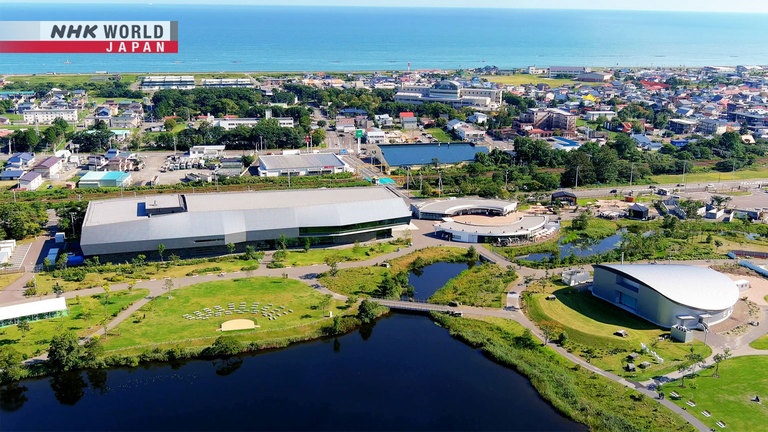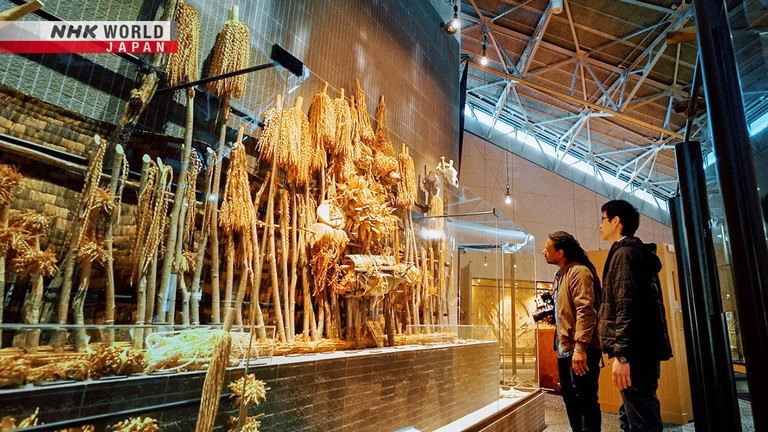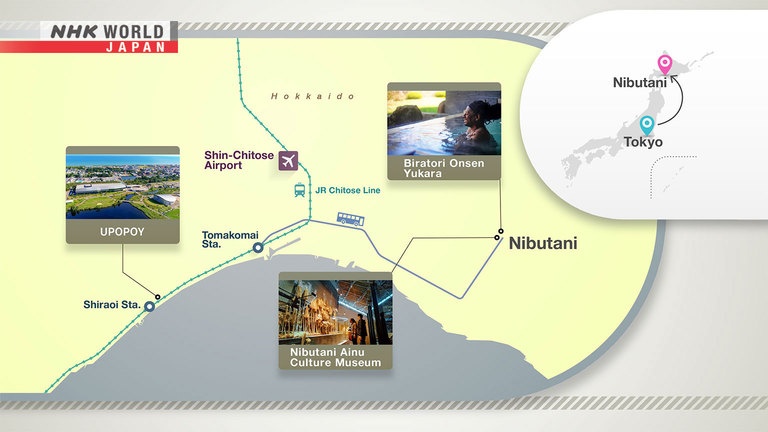Nibutani the Ainu, Living with Kamuy
The Ainu people are the indigenous people of Hokkaido Prefecture, Japan's northernmost main island. They developed their own distinct language, history and culture, which were quite different from Japanese, and also lived in northern Honshu, Sakhalin and the Kuril islands. The Ainu people hunted and foraged for edible wild plants, coexisting with the natural environment. They produced powerful, beautiful folk art and craftworks, and they practiced many seasonal rituals to give thanks for the blessings of nature. On this episode of Journeys in Japan, US filmmaker Martin visits Nibutani, an area in Hokkaido with a strong connection to the Ainu people, to discover how they have managed to maintain their culture, handicrafts and beliefs to this day.
Upopoy

This museum and culture center in Shiraoicho was built by Japan's central government to promote and develop the Ainu culture.
Nibutani Ainu Culture Museum

This museum in Nibutani displays items of folk art alongside artifacts from daily life, in order to hand down the history of the local Ainu people.
Biratori Onsen Yukara

This facility offers accommodation and natural hot spring baths featuring carbonated hot water. It also has a display of traditional Ainu craft products.
Access

To reach Nibutani from Tokyo, flights from Haneda Airport to New Chitose Airport take 90 minutes. From there, it takes about one hour by car.
Transcript
"Journeys in Japan"
Deep in the forest,
even the gods breathe quietly.
In this northern land, the abundance overflows.
The indigenous people of this land are the Ainu.
They've lived here since ancient times.
Coexisting in harmony with nature and the gods,
they have their own distinct history and culture.
On this edition of "Journeys in Japan,"
meeting the culture of the Ainu people of Hokkaido.
Nibutani the Ainu, Living with Kamuy
Some 800 kilometers north of Tokyo,
Biratori-cho lies on the west of Hokkaido's Hidaka district.
Martin is a filmmaker from the United States.
Hello. My name is Martin.
I've lived in Japan for two years.
Over the past two years, I've learned a lot about Japan.
I recently learned something interesting.
I'm familiar with the indigenous people of the United States.
The thing that I learned that was surprising
was that Japan has their own indigenous people called the Ainu.
I want to learn about the history and culture of the Ainu.
Martin has come to Hokkaido
to find out more about the indigenous people of northern Japan.
The Upopoy National Ainu Museum.
It was built to teach the history and culture of the Ainu people
which remains little-known in Japan.
Hello.
Okay.
Can you tell me about the Ainu?
The Ainu are the indigenous people of Japan.
The word "Ainu" simply means "human."
The Ainu people have their own unique history, culture and language.
In the past, the Ainu inhabited Hokkaido, Sakhalin
and the Kuril Islands, as well as northern Tohoku.
In the 19th century, violent oppression by the government
led to a significant decline in the Ainu population.
From the start of the Meiji Period in 1868,
the government introduced a policy of assimilation.
It outlawed the Ainu language and traditional culture.
Many customs and rituals came close to dying out.
There was also harsh discrimination.
It's an issue that still remains unresolved.
What is the Ainu population today?
No accurate figures are available, but today
there are said to be 10,000 to 20,000 Ainu people.
They can be found in many parts of Hokkaido.
Many live near here, in the Nibutani area of Biratori.
One place where Ainu traditions remain strong is Nibutani.
It's home to about 400 people,
and 70 percent of them are of Ainu heritage.
Nibutani lies beside the Saru River
which flows down to the Pacific Ocean.
What is this?
These are Ainu houses. They're called "cise."
These cise are covered with thatch - dried vegetation.
When couples married, the whole village would get together to build a cise for them.
In this area, the cise face either east or southeast.
For the Ainu people, those are the important directions.
This museum houses many everyday artifacts from the Ainu people of this area.
This looks like something sacred.
These are "inaw." They're an important offering
presented by Ainu people to the "kamuy" (deities).
This entire structure is called the "nusa" (altar).
Every cise has a nusa, whether big or small.
These Ainu kimono are made of cotton.
These patterns are not like anything I've seen in the West.
The designs are thought to have been talismanic.
The motifs vary from one district to the next.
These pieces look like they could be from Africa.
Yes. The designs are very striking.
These accessories were worn for performing rituals.
These are "ita" (wooden plates).
In the old days, flat pieces of wood were used as plates.
Eventually, carved patterns were used to decorate them.
Wooden trays are now a specialty of Nibutani.
This pattern is truly unique.
Is that an ita you're making?
Yes, the design for this "Nibutani ita"
has been passed down since ancient times by the Ainu here.
Kaizawa Mamoru is an Ainu who was born in Nibutani.
Like his father, he's a woodcarver.
It's such a powerful design.
This motif I'm carving now is called "sik noka."
It represents eyes, perhaps the eyes of the gods.
This spiral pattern is called "moreu noka."
And this one, "ayus noka," represents thorns.
It's quite intricate. The quality of a tray depends on how well it is carved.
This is what it looks like when it's done.
Beautiful!
What kind of wood do you use?
This is "katsura" wood. These days, it's getting hard to find.
On the other side of the Saru River lies the Ioru Forest.
In Ainu, "ioru" means "a place for hunting and foraging."
These are katsura trees. I use this wood for the Nibutani ita trays I carve.
Oh, it's beautiful.
What kind of a place is this?
This is a place that is essential for the life of the Ainu people.
This forest is a source of "yachidamo" ash,
the wood used for building the traditional houses known as cise.
Covering 200 hectares,
the forest is protected as an area for
cultivating the trees used by the Ainu people.
We are cultivating the trees we will need to keep the Ainu culture alive in the future.
In 50 to 60 years, they will be fully grown.
These trees are for our future generations.
The forest also provides abundance in other ways.
Monbetsu Atsushi is a hunter.
What did you just do?
Before we enter the mountain, we offer a greeting to the kamuy.
That's what I was doing.
The Ainu believe the forest is the domain of the kamuy, or gods.
Before setting off to hunt, it's important to first offer prayers to the kamuy.
Monbetsu heads to the mountain almost every day.
Mostly, he is hunting for "ezo shika" deer.
Slush.
Look! That's the spoor of a deer!
Look at that! That's awesome.
That's a good sign.
Usually, I can catch deer like this.
Oh, wow. Nice.
But it's difficult when I'm not alone. The deer can sense your presence.
So, tell me. Why did you become a hunter?
Since I was small, I was surrounded by hunters. I wanted to be one too.
When I began performing our traditional dances,
I learned that the Ainu people were hunters.
That only strengthened my desire to be with the hunters.
Now I have my own gun.
Before, most of the food the Ainu people ate came from hunting and foraging.
Monbetsu's aim is to reclaim that original lifestyle.
He says that when he was young, he did encounter discrimination.
So, tell me. What happened?
When I was in high school, a girl I didn't know at all
saw my face and said, "Ainu are disgusting."
I often heard words like that.
Those things were part of everyday life for me.
When I was a teenager, it was very tough.
Even though we're from different parts of the world,
as a Black man from the United States,
I know the feeling of discrimination.
I feel a connection between us, a certain type of solidarity.
I'm proud of him.
What are you making? Is that made of bone?
This part is made of deer bone. It's done like this.
I make these tools using deer bone and deer horn.
I like to make ornaments.
This is the nail of a bear.
We use the fur too, like this.
Everything is used, either for tools or in other ways.
What does hunting mean to you?
The Ainu are a hunting people. It's an essential part of our culture.
That makes me want to do it all the more, so I can pass it down to the next generation.
Not just the skills, but also the mental and spiritual aspects of hunting.
(Biratori Onsen Yukara)
Nibutani is also an "onsen," or hot spring.
Ooh. This is nice.
In the Ainu people's world view, the deities reside in everything.
That includes the hot springs.
Before bathing, Ainu people in some areas used to call on the god
of the hot spring to help them regain their strength.
This was thought to increase the healing power of the hot water.
This is my best friend, my son.
He's eight years old.
My wife is Japanese.
He looks different than his classmates.
He hasn't experienced discrimination here in Japan.
I always tell him to be a proud Black man
just like the Ainu are proud.
And when I get home, I'm going to share my experiences
that I've had here with the Ainu.
Following a path through the woods,
Martin arrives at an old western-styled building.
This was the house of Neil Gordon Munro,
a Scot who devoted his life to the Ainu people.
Munro first arrived in Japan in 1891 to work as a doctor in Yokohama.
Fascinated by the Ainu, he eventually moved to Hokkaido in 1932.
He came to Nibutani because there were many Ainu people living there.
His residence and clinic were completed a year later.
While working as a doctor in Nibutani, Munro documented the Ainu culture.
He shot numerous films showing the way they lived.
Munro died in this house in 1942 at the age of 79.
Hello. What are you doing?
We've come here to pick wild vegetables.
I teach people the Ainu names of the plants and how they're used in the Ainu culture.
Sekine Kenji teaches the Ainu language.
Many of those attending his classes are local children.
This blue flower is called "toma." In Japanese, it's "ezo-engosaku."
This is "yuktopakina." In Japanese it's "fukkiso."
The Japanese name suggests it's an herb. Actually it's a tree,
very short, but a fully grown tree.
What do you think when you see a tree like this?
It has thorns. That's why it's called "ayus" in Ainu.
That means "tree with thorns."
In Japanese this is "taranome." In Ainu we call it "ayus epuy."
This is "pukusa" (ramps or wild garlic).
In Japanese it's called "gyoja ninniku."
It's an edible plant. It smells like garlic.
Can you tell me about the Ainu language?
The Ainu language is totally different from Japanese.
We can say it's an entirely different language.
It's been passed down orally through the years.
Unfortunately, few people use the Ainu language in their daily life.
I'm not Ainu, but my wife is.
I met her here about 25 years ago when I visited on a biking trip.
When I first met her, she was teaching the Ainu language to children.
I used to help her with her work, and gradually I became the main teacher.
When Sekine's daughter Maya was eight,
she came top in the children's division of an Ainu language speech contest.
This is our daughter, Maya.
Since finishing university, she's lived in Tokyo.
She works to promote the Ainu and their culture.
In fact, she's coming home today. She should have arrived by now.
I think she's at her grandmother's house. Martin, you should meet her later.
Kaizawa Yukiko is Maya's grandmother.
What is this?
This is "attus." It's a woven fabric that we use to make traditional Ainu clothes.
We use the bark of the Manchurian elm. In Japanese it's called "ohyonire."
It's so soft and flexible.
I can't believe it's made of tree bark.
Weaving is a traditional craft in Nibutani.
Handwoven attus fabric is highly breathable,
water resistant, and very durable.
The patterns follow traditional Ainu designs
as used in the Nibutani woodcarvings.
I'm home!
Oh good.
"Irankarapte" ("hello").
- Nice to see you.
- It's nice to see you.
What made you come over today?
I came home to pick wild vegetables
and learn cooking from my grandmother. I'll video it.
Oh, can I come with you?
Of course! Please come with us.
This is definitely my first time.
First time. How is it?
It's really pretty.
Pretty. Yeah.
There are many plants we use in cooking.
This is called "oubayuri." We use the roots to make dumplings.
This is "nirinso" (windflower). It's an essential plant.
We cook this in many dishes, such as venison stew.
It tastes so good. Let's eat some when we get home.
And this is "fuki" (butterbur). After we pick the buds,
we have to leave the plants a few years to grow back.
After they've been picked, they only produce small buds.
The plants are alive, but the buds are too small to be used.
When I was young and I went out fishing,
I was taught to leave all the entrails for the foxes and other animals.
I've learned a lot from the Ainu culture about how
everything in nature goes around in cycles.
So the Ainu found ways to live sustainably on their land in harmony
and with nature long before
anyone started talking about the ecosystem or recycling.
That's beautiful. It's really cool.
I promote the Ainu culture not because I feel it's my duty
or because it's my role to do it.
I want many people to know about the Ainu
because I think they are really cool and smart.
It's not because I feel a responsibility.
I think Ainu culture is beautiful
and I want many different people to know about it.
We've picked enough. Maya, you must be hungry.
When we get home, we'll eat venison stew.
These dumplings are made from the starch
of the oubayuri plants we picked in the mountains earlier.
They're really delicious.
It's said that in the old days the Ainu would put a cooking pot
over the fire before going out hunting.
That indicates the abundance of food in this area.
And I think this is what gave rise to this beautiful culture,
with its wonderful designs.
I'm used to going to the supermarket to "hunt" and "gather" my food.
Today we gathered plants growing wild in the forest by that stream,
and we're eating deer from the same forest.
This meal connects me back to the earth.
And it's delicious.
Nibutani was an amazing place.
The journey was meaningful and enlightening.
I experienced the traditions and culture
of the indigenous people here in Japan,
the Ainu.
It was moving to see them coexisting with nature,
offering thanks and prayers
to the spirits and their ancestors.
Despite the discrimination they face,
they are proud to be Ainu.
It filled me with joy to see the Ainu way of life,
to meet the people who are preserving this unique culture.
I'll remember this place forever.
I'm going to bring my family here one day.
To reach Nibutani from Tokyo,
flights from Haneda take 90 minutes
to New Chitose Airport.
From there, it takes about one hour by car.